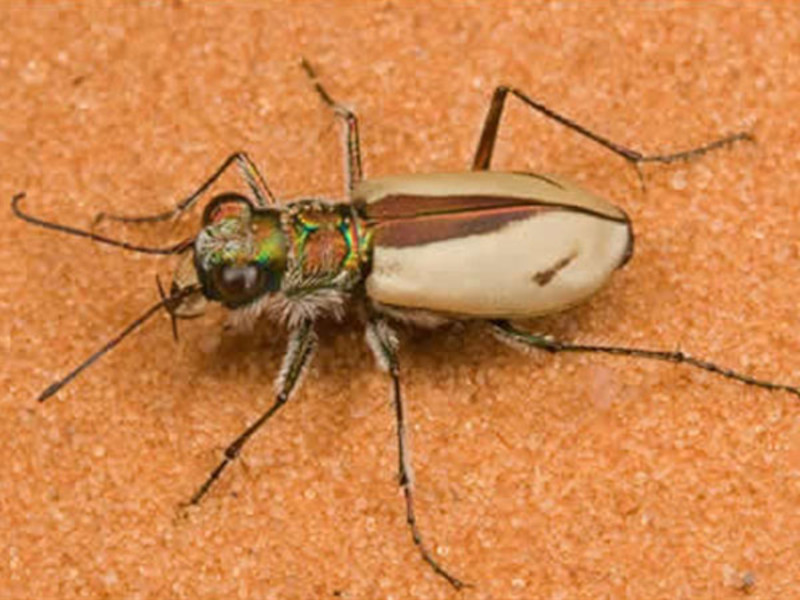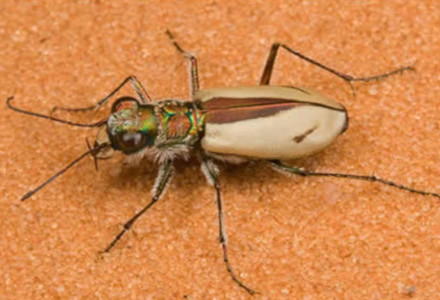
Photo Credit: USFWS
Public Domain Image
Coral Pink Sand Dune Beetle Facts
- This arthropod bears the descriptive, if lengthy, common name of the Coral Pink Sand Dune Beetle. That somewhat exhausting term currently represents its only recognized common name. It simply isn’t seen enough for alternate terms to come to mind.
- Scientists, however, know the species by its technical name. That’s the hard to pronounce term of Cicindela albissima. Researchers only recently discovered the awesome insect, in fact. As a result, it only received its technical name in 1962.
- Sadly, due to the combination of a highly limited range and small numbers, this insect lists as Critically Endangered with the IUCN. Estimates currently place the total current population of this spectacular invertebrate at fewer than 2,000 individuals.
- The Coral Pink sand Dune Beetle also spends the entirety of its life in one tiny area. Typically, this location consists of the same individual sand dune. The majority of individuals venture less than 1,000 ft (300 m) from where they hatched from their eggs.
- Given these factors, the potential of habitat loss understandably constitutes one of its greatest threats. Other dangers also obviously threaten the small insect, though. The ongoing effects of climate change no doubt rank at or near the top of this list.
Related Articles
Golden Tortoise Beetle Tansy Beetle Frog Legged Beetle
Photo Credit: Mark Capone / USFWS.
Public Domain Image
Coral Pink Sand Dune Beetle Physical Description
Much as with many insects, the Coral Pink Sand Dune Beetle displays the principle of sexual dimorphism. In its case, females usually reach a larger size than males. Both genders remain tiny. That’s because an overall average body length measures less than 0.5 in (12 mm).
Although relatively small, the coloring of the magnificent creature remains rather striking. Also, the body generally appears as either brown or bronze in color. The upper thorax, furthermore, possesses a highly metallic sheen, making for a truly striking appearance.
While the wing cases of most individuals usually remain concealed, these appear as a brilliant white. The eyes also develop quite large, at least in comparison to other beetles of its size. In addition, the legs grow relatively long, to keep the body away from the hot sand.
Its most noteworthy feature, however, easily remains the presence of numerous bright white hairs. These fascinating features line much of the small body and legs. Researchers have theories as to the reason for this trait, but have reached no definitive conclusion.
- Kingdom: Animalia
- Phylum: Arthropoda
- Class: Insecta
- Order: Coleoptera
- Family: Carabidae
- Genus: Cicindela
- Species: C. albissima
Photo Credit: USFWS Mountain-Prairie
CC License: https://bit.ly/3jHu7Lm
Coral Pink Sand Dune Beetle Distribution, Habitat, and Ecology
The Coral Pink Sand Dune Beetle evolved as endemic to Utah, in the United States, in North America. Even more specifically, the species only inhabits the Coral Pink Sand Dunes geologic feature. This, quite understandably, serves as the source of the common name.
The color of the sand dunes it evolved as native to remains unique. It also forms the reason the invertebrate evolved its own distinctive coloring. With its limited numbers and highly restricted habitat, survival of every individual is of paramount importance to the species.
Mating usually occurs in the spring, and the larvae reach adulthood the following spring. The remarkable small creature also evolved as entirely carnivorous. Mature adults primarily prey upon flies and other small arthropods they can catch on the dunes.
Larvae remain in small burrows and feed on any small arthropod that wanders by. Yes, the primary threats to its existence include habitat loss due to climate change. But, the use of recreational vehicles such as buggies on the dunes also poses a severe threat.
Fortunately, its habitat lies within part of the Coral Pink Sand Dunes State Park. The use of buggies in the region the fabulous species inhabits has now been banned by the U.S. Fish and Wildlife Service. The impact of this on its numbers remains undetermined at this time.
Species Sharing Its Range
Desert Locust Giant Camel Spider Scarab Beetle
Check out our other articles on 7 Breathtaking Beaches of the World, Flame Azalea, Bald Uakari, Eastern Tent Caterpillar, Hawksbill Sea Turtle, Bornean Flat Headed Frog, Puffin

